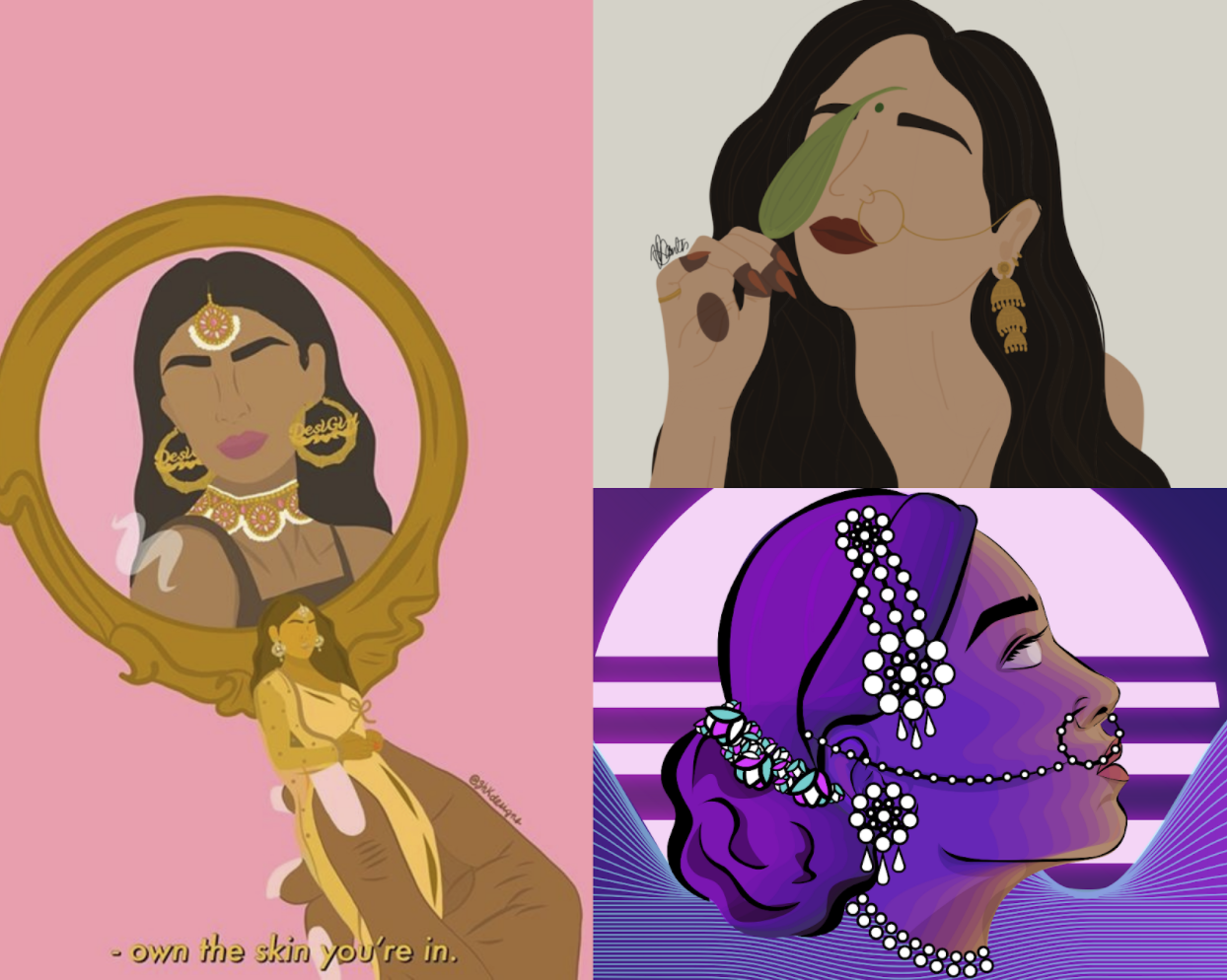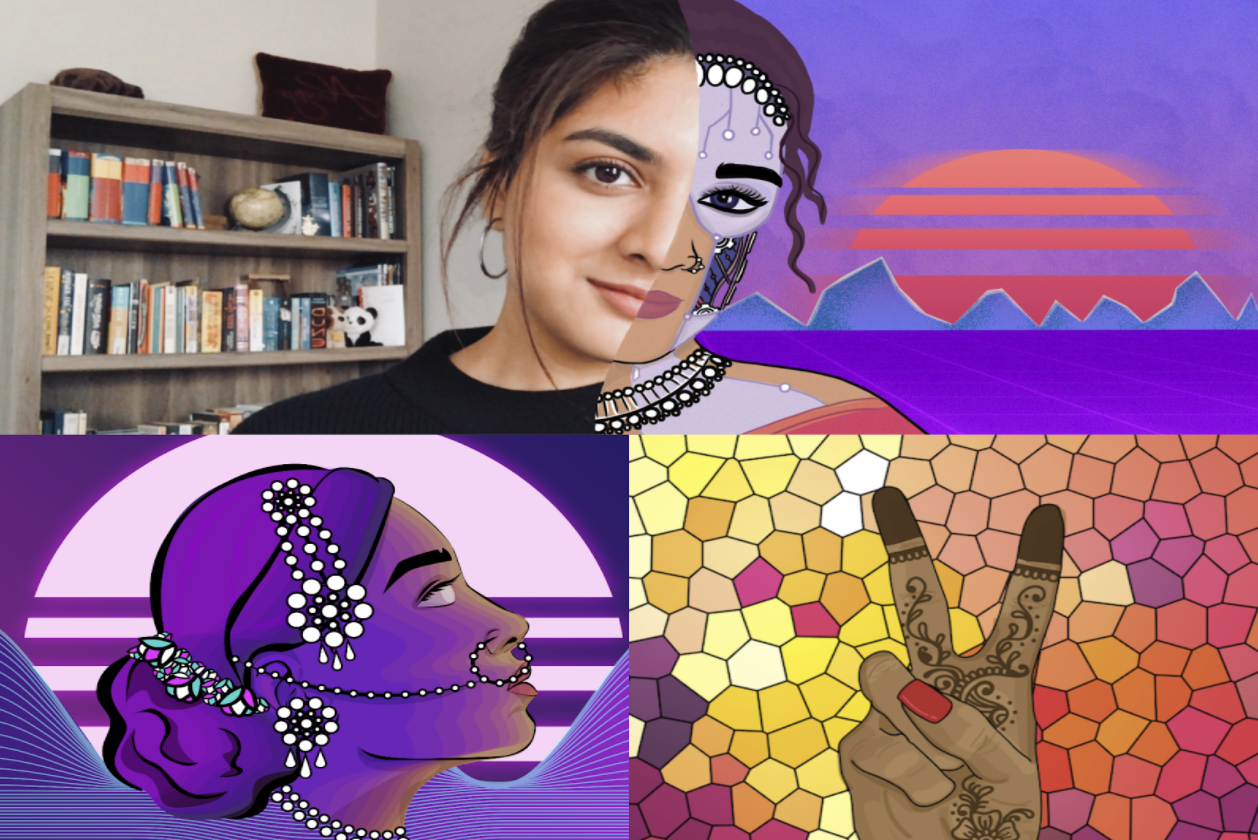Unapologetically Desi, A Provocative Approach to Art by South Asian Women
To all the brown girls out there who grew up longing for representation—it’s finally here.
BY: MALIKA DAYA
*The artists featured for this piece were independently and intentionally chosen by the writer because of their diversity as South Asian Women & the value of their work.
Art by the Featured Artists
As a young girl growing up, I was always comparing myself to the white girls in my class. Why wasn’t my skin as fair? Why was I not as pretty as them? Why wasn’t I born with blonde hair and blue eyes? All the pretty girls on TV looked like that.
I mean, don’t get me wrong, I spent most of my childhood binging Bollywood movies. I never really grew up understanding the mainstream pop media references because the only references I got were those that referred to Shah Rukh Khan and Madhuri Dixit in Dil Toh Pagal Hai. The music my parents played on blast on every road trip happened to be the Bollywood classics like Lata Mangeshkar and Kishore Kumar. I used to beg them to switch it to Virgin Radio, but who listens to the youngest in the family anyway?
But in some weird way, it became like comfort food. Whenever I felt alone, a song about love in Hindi or seeing a South Asian actress on the screen at the Movie Dome (a long-gone, independent, Bollywood movie theatre in Calgary) made me feel less like an alien, living my “Western” life in my Indian skin. My connection to Bollywood was an indescribable bond, where I saw reflections of myself and where I began to dream. And it was the characters in those movies and the actresses on the screen that became my role models when I was a little girl.
But I felt caught in between two worlds. There were gaps that even Bollywood couldn’t fill.
I think brown girls in Canada are used to shrinking themselves down, are used to fitting into the mould others carve out for them, of being flexible like Sima Aunty from Indian Matching Making famously quoted. We are brought up trying to reconcile being brown and being Canadian—how the fuck do you even do that?
At home we’re eating all the desi food, speaking in our family’s mother tongue and at school we are going off, in perfect English (for many of us our first language), about Channing Tatum or Megan Fox—knowing very well that the sexiest man and woman alive are Ranveer Singh and Deepika Padukone in Ram Leela. But here is the thing, us desi girls, are fluid in both spaces. Like a chameleon changes colours, we alter our identities in different spaces. We aren’t even being fake, we are just super fucking complex.
And we no longer care for the one-dimensional characters we see in Priyanka Chopra in Baywatch or Kajol as she runs around in a saree. (Yes, that’s a hot take, deal with it). But we are looking for provocative art. Art that is a complex, three-dimensional version of ourselves reflected back at us off a screen.
Art that makes you feel less alone.
And it wasn’t until recently that a beautifully unexpected shift occurred in the “media,” I began to see myself. I began to see myself in graphic illustrations, as an emerging collective of South Asian Diasporic women were creating art that is a reflection of who we, South Asian women, are —in all of our complexity and diversity.
So I reached out to three powerhouse graphic illustrators to get their take on what it means to be a rani (a queen).
ZHK Designs - Zoe Harveen Kaur Sihota (She/Her)
Art courtesy of Zoe Harveen Kaur Sihota (She/Her) via ZHK Designs
Zoe is a 22-year-old, Political Science, Western University graduate, and artist from Calgary. She comes from a Punjabi-Sikh background and identifies as South Asian. Zoe loves making statements through her art and her bold and outspoken personality speaks for itself, as her work projects a fantastic mix of her imaginings of what the world should look like. ZHK Designs is a beautiful blend of various aspects of South Asian culture infused with feminist ideals. Zoe’s motto is to “educate and empower.”
To all of the brown girls who are exhausted of the Sima aunties commenting on our weight, of their inability to understand mental health, and their insistent urge to shove their noses all up in our business about literally everything—Zoe understands us. ZHK Designs works to challenge normative stereotypes of being a South Asian woman in her series "What Would Poo Do," "Desi Girl Horrors," and "Things Every South Asian Woman Has Heard.”
When asked what being a South Asian Diasporic woman meant to her, Zoe wrote, “There are so many layers to this question, I think I have an obligation to continue to challenge the patriarchy and social norms within our community, while also empowering South Asian females around me. I always want to empower my peers, and I think most of my empowerment stems from feminism and questioning social norms.”
ZHK Designs is working towards breaking down old norms, challenging uneven practices within the South Asian community, and addressing the lack of confidence and female representation in media. Zoe shares, “One of my biggest goals is to allow women to feel as though they are valued, they are important and they can do anything, no matter who they are, what they look like or what they identify with/as. I want our community to reach a point of confidence where South Asian women are completely comfortable with themselves and the choices they make. Even when I draw women, I want them to be powerful and appear to be confident, so that anyone can view the piece and say that's me."
Vdantesart - Vanessa Dantes (She/Her)
Art courtesy of Vanessa Dantes (She/Her) via Vdantesart
Vanessa Dantes is a Christian, Indo-Canadian artist, based in Australia, originally from Calgary. In Vanessa’s work, you’ll discover aspects of her intersectional identity: a cross to represent Christianity, mehndi symbolic of her Rajasthani heritage, and Black Lives Matter written in Hindi, Urdu, and English representing the languages she speaks.
Throughout her life, as with many other South Asians living in the diaspora, she was questioned to prove her validity as a South Asian. Vanessa’s Indian identity was questioned and interrogated, as other Diasporic Indians claimed that there is no way she’s a real Indian given her religious affiliations.
Vanessa shares, “This sort of attitude causes so many of us Diasporic Christian Indians to have an identity crisis that is deeper than “Am I western or am I Indian?” We question who we are down to our religious beliefs and for many of us, it feels like we constantly need to prove to both our Western and South Asian counterparts that our identity is valid. I create my art to represent us and to possibly prevent future generations from facing this same identity crisis.”
Identity crisis. We all face it, every single day. Some of us are “too” light-skinned, some “too” dark, some of us have been a part of various diasporas for “too” many generations, others of us are not a part of the mainstream religions of South Asia, and all of a sudden our entire identities are put under a microscope. Are we Indian enough? Are we Western enough? Are we enough of anything?
Vanessa shares, “Being a South Asian Diasporic woman is such a sacred and beautiful thing to me. It’s an identity in and of itself. This is especially true being Indo-Canadian (Indian Canadian). We have moulded our own cultural identities in a way others have not had the opportunity to. I think it’s particularly beautiful being able to pull different aspects of being South Asian and Diasporic together to create an identity wherein future generations don’t need to fall victim to possible toxic aspects of the South Asian culture.”
Ranipuri.Art - Rukhsar Ali (She/Her)
Art Courtesy of Rukhsar Ali (She/Her) via Ranipuri.Art
Rukhsar is a Pakistani American Canadian, Ismaili Muslim who is a digital artist, writer, and masal chai connoisseur!
“As an artist, I'm very informed by my background as someone born in America, raised in Canada, to Pakistani parents who did an amazing job of keeping our Pakistani culture alive in the Western world. From so early in my life I've wanted to reconcile my cultures and I'm in a place now where I happily get to do that and unapologetically be myself.”
Rukhsar’s interest and research in postcolonial studies and science fiction inspires much of the digital art she creates, allowing her to explore identity from a decolonial lens. She is also greatly inspired by her Ismaili faith and tries to explore her relationship with it, and spirituality as a whole, in the Western world.
Reflecting on her identity as a South Asian Diasporic woman, Rukhsar shares, “So often I've found myself lost in the battle for supremacy between my Eastern and Western cultures, unable to reconcile my true identity with who I'm 'supposed' to be. Now, I've come to understand that there is no right or wrong way to be a Diasporic South Asian woman because I am the one who defines what that means for myself, and additionally, that definition isn't universal for women in similar positions.”
Ranipuri.art explores the science fiction genre and subverts traditional sci-fi expectations. The history of the genre continually showcases white protagonists and BIPOC sidekicks, or many times, BIPOC as the alien other. Rukhsar works to highlight BIPOC characters and cultures as the protagonists of their stories “because BIPOC deserve to see themselves in the 'future' too.”
Yes, we do, sister.
This emerging collective of graphic illustrators have beautifully brought to life the diversity among us and the power within us. It’s time we all unapologetically own our hyphenated identities.



